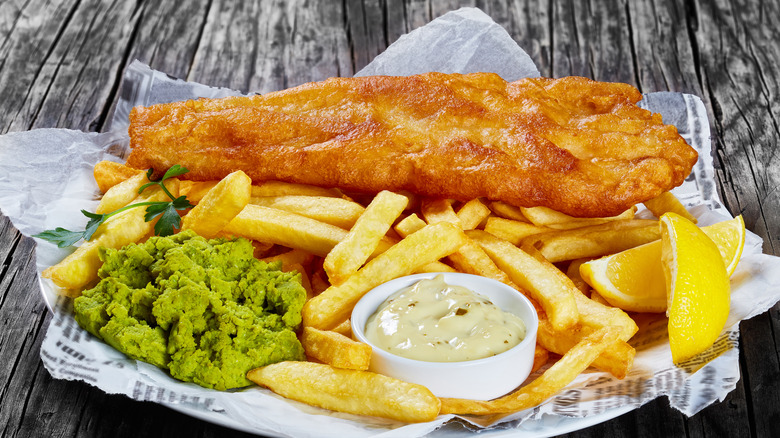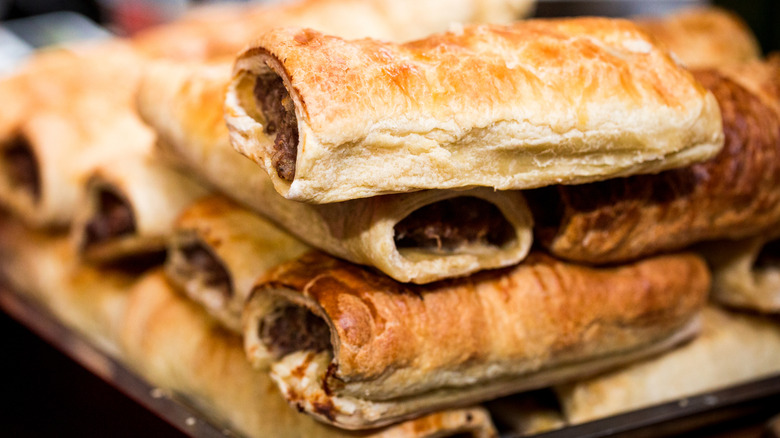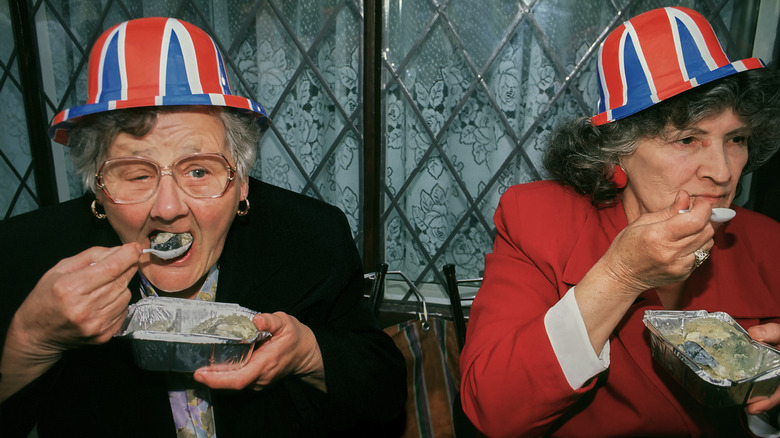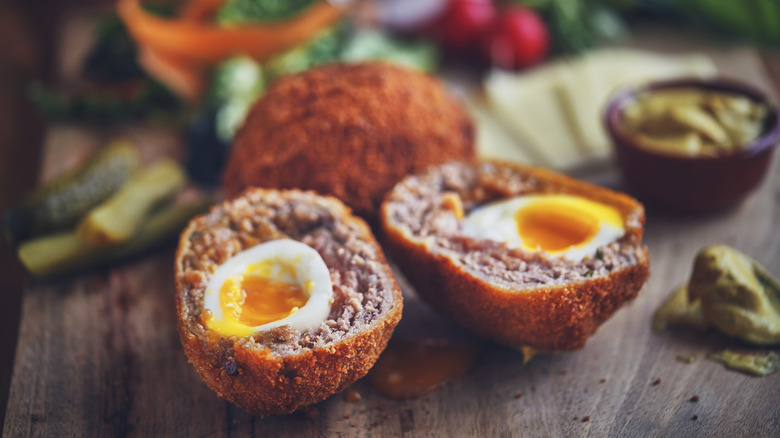Is British Food Really As Bad As All The Jokes Make It Out To Be?
Websites and social media are awash with content bashing British food. The dining habits of Brits have been a subject of banter going back long before the dawn of the internet: Everyone from Virginia Woolf to Jackie Mason has taken a crack at this much-maligned cuisine over the decades. The subject arouses almost as much wonder as it does amusement — how can a nation that once conquered a quarter of the world and had access to so many exotic flavors and ingredients produce such bland food?
Many reasons for the notoriously poor quality have been offered, not least the impact of rationing during and after World War II on British cooking. Conservative tastes and lack of interest in cooking may also play a part, and the traditional national dish of fish and chips (french fries) is indicative. Pretty much everyone in the U.K. loves a chippy dinner, but let's face it — a lump of battered fish with a heap of chipped potatoes is hardly a riot of flavors. Chicken tikka masala, a mild curry dish invented to cater to British palates and named another national dish in the early 2000s, is pretty wild by comparison. Despite all the jokes, however, there has been something of a renaissance in the nation's culinary scene over the past few decades, with some of Britain's finest chefs and restaurateurs promoting quality homegrown ingredients and spruced-up versions of old classics. But the question still remains: Is British food still really bad?
The bad old days of British food
If you think British food is bad now, speak to a native who grew up in the '70s or '80s. Those were the dark days when many people lived on poor (but heavily advertised) ready-made options such as Birdseye Crispy Pancakes, Fray Bentos cook-in-the-tin pies, Bernard Matthews turkey products ("Bootiful!"), with something like Arctic Roll or Angel Delight for dessert. Quantity was often valued over quality, as some depressing adverts for British meat in the 1980s reveal. Around the same period, a company called Vesta gave some families their first taste of international cuisine with a range of boxed DIY kits that included beef curry and chow mein. They're virtually inedible to a more enlightened modern palate, but they at least let Brits know that there were more exotic flavors out there.
Bad British food articles often focus on an over-reliance on cheese and meat products, particularly pork: Pork pies, scotch eggs, and sausage rolls are still incredibly popular hand-held meals, with Greggs bakery chain selling around 130 million of the latter every year. This snack culture has turned Britain into a nation of sandwich eaters, with pre-packaged butties becoming a vast multi-billion dollar industry. Indeed, some Brits would rather eat a chiller cabinet sandwich than make the effort to cook. Also, factor in the average Brit's love of takeaway food and the generic menus served up to beer aficionados in British pubs (steak and ale pie, Hunter's chicken, etc.), and it still paints a bleak picture.
British food considered the worst
You can find many lists online of the worst British foods. It is very subjective, so let's be charitable and say some of the regular offenders are an acquired taste. Jellied Eels (the iconic Cockney street food) regularly feature, as do mushy peas, a common side order with fish and chips. Marmite doesn't just put off foreign visitors — the yeast extract spread is so divisive among Brits that its TV adverts often lean into how vile it is to some people's taste.
Other dubious British favorites include pork pies, which put some people off due to the high content of jelly surrounding the meat; black pudding, a type of blood sausage often served with a full breakfast; and Stargazy Pie, a Cornish fish dish with sardine heads poking out of the crust. North of the border in Scotland, haggis gets a bad rap, although modern versions often switch out the traditional sheep's intestine casing for a synthetic one. Travel guru Rick Steves is a fan.
Two controversial snacks are closely related: The chip butty and the crisp sandwich. Brits will slap anything between two slices of bread, but french fries or potato chips are a step too far for many people. Others consider them great comfort food, and cheese and onion flavor is the nation's favorite crisp sandwich filling. Back in Scotland, the phenomenon of the deep-fried Mars Bar is popular in Scottish chippies. Yes, you read that right — it is a chocolate bar dunked in batter and fried.
Some great British dishes to try
Many British dishes are beautiful in their simplicity. Just take the bacon sandwich. It's just a few rashers of back (Canadian) bacon in buttered white bread, but it's pretty hard to beat. No other ingredients are necessary, and adding condiments can distract from the flavor of the meat. Sturdy classics like fish and chips, a Sunday roast, and the full English breakfast are all beloved for a good reason when they're done right with quality ingredients. Shepherd's Pie is another old-fashioned dish that stands the test of time, a basic combo of minced lamb topped with a layer of creamy mashed potatoes. It's nothing fancy, but it certainly warms the heart on a cold winter's day.
The British fondness for snack foods, particularly of the meat-in-pastry variety, baffles some visitors. Again, it's down to quality and freshness. Scotch eggs, sausage rolls, and Cornish pasties can be pretty horrid when eaten cold out of a supermarket chiller cabinet, but they can be absolutely delicious when eaten fresh out of the oven. In the same category, you can get a little British-Indian fusion with a wonderful Chicken Balti Pie, which has replaced more traditional offerings like steak and kidney at many football grounds around the country. Britain also has its fair share of evocatively-named desserts like spotted dick and Eton mess, but few are as revered as the cream tea. It's a heavenly treat when you have fresh, warm scones lathered with clotted cream and strawberry jam.
The rise of modern British cuisine
Despite all the jokes about British food, the quality has been trending upward for a few decades and is even gaining fans on social media. The gradual rise perhaps corresponds with the evolution of the British celebrity chef since the 1970s. While early TV cooks like Delia Smith and Keith Floyd basically just taught people how to make a meal, more dynamic personalities like Gordon Ramsay and Jamie Oliver in the late '90s helped change the way Britons cooked and thought about food.
The cultural phenomenon of Cool Britannia may have also helped. Everything British was suddenly hip again, and bold new chefs like Heston Blumenthal started opening restaurants that did exciting new things with food while attracting celebrities and Michelin stars in equal measure. Over the same decade, the gastropub concept gained popularity, increasing the quality of classic but basic pub grub to something approaching restaurant standards.
In more recent years, a new wave of chefs has begun championing the tastes and flavors of their home country and given rise to modern British cuisine that also plays well on an international stage. Nowadays, British food still retains a reputation for being bland and unappealing, and it is still possible to eat some very bad meals. But putting aside all the banter, the nation is also developing a newfound pride in its cuisine and has plenty for foodies traveling to the U.K. to seek out and enjoy.




